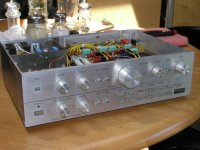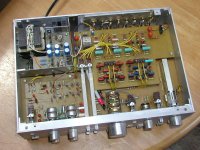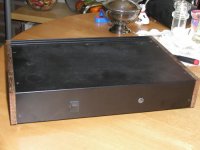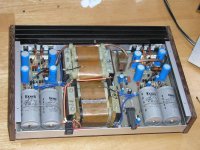It seems that there is certain interest in my work , so I present here my actually first creations done some 20 years ago.
, so I present here my actually first creations done some 20 years ago.
My first all out project was a preamp with all possible features. At that time it was running on 220V and was using DIN connectors. You might not believe me but only knobs and a groove across the front face were custom machined, all other openings were drilled out and filed by hand. As I remember it took me a whole day to do it.
My first all out project was a preamp with all possible features. At that time it was running on 220V and was using DIN connectors. You might not believe me but only knobs and a groove across the front face were custom machined, all other openings were drilled out and filed by hand. As I remember it took me a whole day to do it.
Attachments
All the boards were designed and etched by me and as usually I wanted to avoid excessive wiring. The circuits are arranged in two levels, where bottom contains phono EQ and power supply and top actual preamp and elaborate filters. I think there was not a single feature I didn't put there. But then, I was more influenced by Japanese makers then by Mark Levinson.
But then, I was more influenced by Japanese makers then by Mark Levinson.
Attachments
At that time I was also into mini systems (315mm width) so both preamp and amp were of that size. The amp was low distortion class B, nothing particular about it if not the small size. It delivered 50 W and I never needed more. The chassis is not done from 1/4" aluminum, but from steel I used from other equipment chassis and cut to size.
Attachments
Very nice!
The front panel looks very nice as well. Rub on transfers for the letters?
Just as a matter of interest, why the different transformers per channel?
One transformer of twice the size is usually cheaper than two, so I'm interested in your opinion given you used two transformers here.
Also, what transformers are those?
The front panel looks very nice as well. Rub on transfers for the letters?
Just as a matter of interest, why the different transformers per channel?
One transformer of twice the size is usually cheaper than two, so I'm interested in your opinion given you used two transformers here.
Also, what transformers are those?
The transformers were changed later for 110V since original used 220V. Two of them fitted better in available space, I also think that using separate transformers for ea. channel is better (you know true mono construction). Now I would use much bigger transformers thou.
Dry transfer lettering always worked good for me, and even after 20 years you don't see much wear.
Dry transfer lettering always worked good for me, and even after 20 years you don't see much wear.
I must agree that seperate channel transformers are a very good idea indeed. This method gives greater channel seperation and much better power figures. I have a Harman/Kardon HK402A
and it uses seperate trannies. It's only rated at 60W a channel into 8 ohms, but I can load it with four or 2 ohms and easily get more power than expected. Thus, this amp uses (harman/kardon watts) which is like RMS compared to Peak.
and it uses seperate trannies. It's only rated at 60W a channel into 8 ohms, but I can load it with four or 2 ohms and easily get more power than expected. Thus, this amp uses (harman/kardon watts) which is like RMS compared to Peak.
I'm not arguing, just asking some questions.
If the amp design has a high PSRR, why would separate transformers give bettern separation?
If a channel needs more power, wouldn't be easier to pull from a supply that's twice as large? (i.e. more transient response possible).
What do you mean by 'better power figures'?
I measured my Technics 55w power amp supplies a while ago and was surprised to find they are much higher voltage than expected (I can't remember the number now). It's sized to be a 150w amp as far as the voltage goes, but they rate it at 55w. I'm wondering if this is the same thing you're seeing in the Harmon Kardon. (Not trying to compare the two, it's just interesting).
Part of the reason I'm asking is that for my home theater, 10 power transformers is a whole lot more expensive than 1 or 2
If the amp design has a high PSRR, why would separate transformers give bettern separation?
If a channel needs more power, wouldn't be easier to pull from a supply that's twice as large? (i.e. more transient response possible).
What do you mean by 'better power figures'?
I measured my Technics 55w power amp supplies a while ago and was surprised to find they are much higher voltage than expected (I can't remember the number now). It's sized to be a 150w amp as far as the voltage goes, but they rate it at 55w. I'm wondering if this is the same thing you're seeing in the Harmon Kardon. (Not trying to compare the two, it's just interesting).
Part of the reason I'm asking is that for my home theater, 10 power transformers is a whole lot more expensive than 1 or 2
OKay, to answer your questions:
first of all, when you draw large transients of power from a PSU, you'll cause a voltage drop no matter what even if small. WHen you have a seperate PSU for each amp, the amps haven't got much ease in interfering with eachother. Essentially, one amplifier causes a voltage drop on a bass transient or something whil the other is trying to produce vocals, the vocals on the other amp get reduced in amplitude at each transient and this can become noticeable. Basically, it's an easy way to get away with minimal size supplies and still give each amp less disturbance in the line.
For home theater it really depends on what your willing to pay for or listen to. You can achieve exceptional results with only one transformer for a pair or more of amps, but this transformer and it's supply capacitors mustn't let transient voltage drops occur.
Most dolby and DTS recordings have very very bad distortion figures on transients anyway so it doesn't matter too much with home theater. And try not to believe in THX labels either, it's a publicity stunt.
BTW, my next set of amps will run off of the same PSU and trannie and deliver: 2X600W into 4ohms, 2X100W into 8ohms, and 1X80W into 16ohms all from a 5kva transformer but I'm going to use 1 farad supply caps to eliminate transient problems. As you may see, it isn't a necessity to have seperate PSU's, it just a luxury if you can afford it...
Well... many limiting factors do occur in amplifiers and also, there are many ways of rating output power. In the Harman/Kardon industry, they often made huge understatements in the ways of power. Also, Harman/Kardon amplifiers are very very well designed for high current capability and excellent current handling. They will not drop off or flake out like many amplifiers these days when you demand bass from them. Thus, they seem way more powerful than the usual amp of the same rating. One good example of HK current abilities is that I could run my amp into a set of 4ohm and 8ohm speakers in parallel which results in a total load impedance of 2.6 ohms. I could crank the amp until it's gain stage distorted and the output transistors didn't even get hot, while if you did this to a modern home reciever or amp, it would turn into a nice fireworks show!
first of all, when you draw large transients of power from a PSU, you'll cause a voltage drop no matter what even if small. WHen you have a seperate PSU for each amp, the amps haven't got much ease in interfering with eachother. Essentially, one amplifier causes a voltage drop on a bass transient or something whil the other is trying to produce vocals, the vocals on the other amp get reduced in amplitude at each transient and this can become noticeable. Basically, it's an easy way to get away with minimal size supplies and still give each amp less disturbance in the line.
For home theater it really depends on what your willing to pay for or listen to. You can achieve exceptional results with only one transformer for a pair or more of amps, but this transformer and it's supply capacitors mustn't let transient voltage drops occur.
Most dolby and DTS recordings have very very bad distortion figures on transients anyway so it doesn't matter too much with home theater. And try not to believe in THX labels either, it's a publicity stunt.
BTW, my next set of amps will run off of the same PSU and trannie and deliver: 2X600W into 4ohms, 2X100W into 8ohms, and 1X80W into 16ohms all from a 5kva transformer but I'm going to use 1 farad supply caps to eliminate transient problems. As you may see, it isn't a necessity to have seperate PSU's, it just a luxury if you can afford it...
Well... many limiting factors do occur in amplifiers and also, there are many ways of rating output power. In the Harman/Kardon industry, they often made huge understatements in the ways of power. Also, Harman/Kardon amplifiers are very very well designed for high current capability and excellent current handling. They will not drop off or flake out like many amplifiers these days when you demand bass from them. Thus, they seem way more powerful than the usual amp of the same rating. One good example of HK current abilities is that I could run my amp into a set of 4ohm and 8ohm speakers in parallel which results in a total load impedance of 2.6 ohms. I could crank the amp until it's gain stage distorted and the output transistors didn't even get hot, while if you did this to a modern home reciever or amp, it would turn into a nice fireworks show!
It all depends on what you whant to get out of your system. I believe that separate power transformers are giving you better value for the money than $300 power cords. With them come separate bridges for positive and negative rails (if not discreet soft recovery diodes). At least go for separate transformers for main channels and another one for center and surround. Depending on the rest of your system, but for me its not a law of diminishing returns anymore.
With them come separate bridges for positive and negative rails (if not discreet soft recovery diodes). At least go for separate transformers for main channels and another one for center and surround. Depending on the rest of your system, but for me its not a law of diminishing returns anymore.
A large transformer will be more power-efficient and stiffer (i.e. less load dependent) than two smaller transformers of the same total rating.
Hence it might be a good idea both environmentally and sonically to use only on. Depending on how far you want to go, you can always use separate common mode chockes, rectifiers and filter caps for the channels.
In my amp, I have a common rectifier, choke and huge PI-filter. The channel boards are supplied from braided cables (to minimize the magnetic field) passing signal lines only at right angles and input stages only at a great distance. Then each board has its own 3x 4700 uF per rail as local decoupling.
Eric
Hence it might be a good idea both environmentally and sonically to use only on. Depending on how far you want to go, you can always use separate common mode chockes, rectifiers and filter caps for the channels.
In my amp, I have a common rectifier, choke and huge PI-filter. The channel boards are supplied from braided cables (to minimize the magnetic field) passing signal lines only at right angles and input stages only at a great distance. Then each board has its own 3x 4700 uF per rail as local decoupling.
Eric
That is what I prefer too.
Capslock.
I also prefer 1 trafo. That doesn't mean you can't
use separate rectifiers.
One could even provide separate rectifier
for the the inputstage.
To have inputstage well protected from output stage
I find very important.
Of cource different variations could lead to satisfying
result.
Amplified capacitance I also find as a good thing.
Capslock.
I also prefer 1 trafo. That doesn't mean you can't
use separate rectifiers.
One could even provide separate rectifier
for the the inputstage.
To have inputstage well protected from output stage
I find very important.
Of cource different variations could lead to satisfying
result.
Amplified capacitance I also find as a good thing.
Maybe I would use one big transformer for stereo amp now. It was not possible in the pictured amp because my intention was to have very low chassis and two transformers fitted there perfectly. Sometimes looks are important.
Today, I wouldn't build a stereo amp. I always go for monoblocks, because I want to keep my amps close to speakers (especially when using expensive cables, when every foot counts).
Today, I wouldn't build a stereo amp. I always go for monoblocks, because I want to keep my amps close to speakers (especially when using expensive cables, when every foot counts).
HPotter said:
Today, I wouldn't build a stereo amp. I always go for monoblocks, because I want to keep my amps close to speakers (especially when using expensive cables, when every foot counts).
That is the most sensible thing you can do. It makes you most free to use you endstage in different ways.
In an non-active implication it can different.
Preamplifiers, controlamplifiers there you would like to have
everything in one place.
Not to have to "run around in room" when
selecting different features.
But this could also be overcome by using
remote signals.
About Attenuating, Volume Control.
When transfering the signal from signal source,
CDplayer, turntable, to Loudspeaker,
it preferable to maintain the amplitude.
That leaves best margin to background noise.
Background noise can be seen as "the ocean of noise".
It is often expressed in S/N-ratio. Signal to Noise.
When using some meters of Loudspeaker cable,
you get one problem. Transfering high currents
at high speeds.
When using bi-/tri-amping with monoblock mounted
next to woofers, you get another problem.
Tranfering the signal attenuated of Volume control
in centerplaced Preamp, to the Endstage.
My solution is to have a remotely controlled
attenuator, placed next to endstage input.
It can be wire-remote or Infrared-remote.
This solution keeps signal/noise HIGH over
the transfering distance.
The shorter distance a signal is low, the better!
When transfering the signal from signal source,
CDplayer, turntable, to Loudspeaker,
it preferable to maintain the amplitude.
That leaves best margin to background noise.
Background noise can be seen as "the ocean of noise".
It is often expressed in S/N-ratio. Signal to Noise.
When using some meters of Loudspeaker cable,
you get one problem. Transfering high currents
at high speeds.
When using bi-/tri-amping with monoblock mounted
next to woofers, you get another problem.
Tranfering the signal attenuated of Volume control
in centerplaced Preamp, to the Endstage.
My solution is to have a remotely controlled
attenuator, placed next to endstage input.
It can be wire-remote or Infrared-remote.
This solution keeps signal/noise HIGH over
the transfering distance.
The shorter distance a signal is low, the better!
It uses stepped switches
CMOS 40193 up/down counter is remotely controlled
CMOS 4051 8-channel analog multiplexer
resistor divider
1 resistor is in series with incoming signal
where only the 8 resistors are switched to GND
the CMOS FETS works best around GND
this is repeated
twice with a buffer OP in between
to get 8x8=64 steps -1dB/step
CMOS 40193 up/down counter is remotely controlled
CMOS 4051 8-channel analog multiplexer
resistor divider
1 resistor is in series with incoming signal
where only the 8 resistors are switched to GND
the CMOS FETS works best around GND
this is repeated
twice with a buffer OP in between
to get 8x8=64 steps -1dB/step
- Status
- This old topic is closed. If you want to reopen this topic, contact a moderator using the "Report Post" button.
- Home
- Amplifiers
- Solid State
- And this is how it all started



